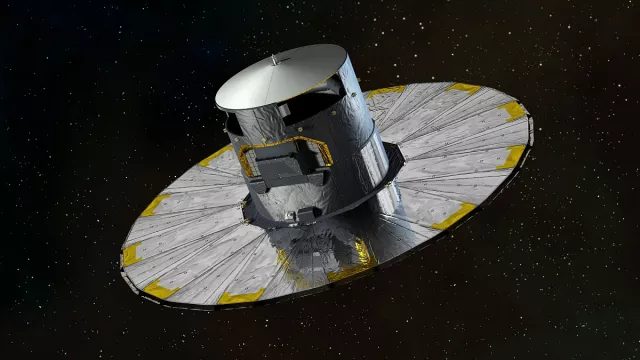The ambitious goal of the Gaia spacecraft launched by the European Space Agency (ESA) in December 2013 is to chart a three-dimensional map of more than 1 billion objects in our galaxy with unprecedented accuracy. In so doing, it is seeking to tell us more about the mechanisms driving galaxy formation.
Key information
| Mission | Chart a three-dimensional map of part of the Milky Way and gauge the proper velocity of surveyed celestial bodies |
|---|---|
| Domain | Science |
| Launch date | 19 December 2013 |
| Partners | ESA, Airbus Defence & Space |
| Where | In orbit around the L2 Lagrange point (1.5 million km beyond Earth’s orbit) |
| Lifetime | Mission extended to 2025 |
| Status | In operation |
Key figures
- 7-microarcsecond spatial resolution
- 106 CCD sensors
- 2,030 kg: satellite mass
- 1.8 billion stars surveyed
- 10,000+ scientific papers published
Key milestones
- 2030: Fifth and final Gaia catalogue released
- 2026: Fourth Gaia catalogue released
- 2025: End of satellite mission
- 10 October 2023: Focused Product Release
- March 2023: ESA extends mission to second quarter 2025
- 13 June 2022: Third Gaia catalogue released
- End 2020: ESA extends mission to end 2022
- 25 April 2018: Second Gaia catalogue released
- End 2017: ESA extends mission to 31 December 2020
- 14 September 2016: First Gaia catalogue released
- July 2014: Start of science mission
- 8 January 2014: Satellite inserted into orbit around Earth-Sun L2 Lagrange point
- 19 December 2013: Gaia launched by Soyuz-Fregat
- 25 May 2007: Management of Gaia data processing entrusted to Data Processing and Analysis Consortium (DPAC)
- 9 February 2006: Airbus Defence & Space (ex-EADS Astrium) appointed prime contractor
- 12 October 2000: Gaia project adopted by ESA
Project in brief
Launched on 19 December 2013, the Gaia satellite is pursuing the colossal task of surveying no fewer than 1 billion celestial objects (stars, exoplanets, etc.) in an effort to map part of our galaxy by estimating their distance from Earth and proper velocity. And that’s not all, for while Gaia has observed an exceptionally large number of objects, it is also determining their position with unprecedented accuracy—to within as little as 7 microarcseconds (1 arcsecond equals 1/3,600th of a degree).
With Gaia’s observations, astronomers will lift the veil on the formation, structure and history of the Milky Way.
The spacecraft is carrying two optical telescopes that enable it to precisely position celestial bodies and analyse their light spectrum. Three scientific instruments are riding on the probe: BP/RP (Blue Photometer, Red Photometer), to analyse star properties (temperature, mass, age, etc.); RVS (Radial Velocity Spectrometer), designed to gauge the velocity of celestial bodies; and an astrometer to measure their position.
Initially scheduled to last a minimum of five years and already extended several times, Gaia is the sixth flagship mission of ESA’s Scientific Programme.
The satellite was built by Airbus Defence & Space (ex-Astrium).
Science data are processed by 430 scientists and engineers across 24 nations within the Gaia Data Processing and Analysis Consortium (DPAC), to which CNES has devoted a lot of technical and human resources.
CNES’s role
Twenty-five people at the agency’s Toulouse Space Centre are involved in the colossal task of processing Gaia data. The team designs, develops and validates the algorithms required to do this.
Their role is to tease out information from the raw data collected by Gaia, putting them into usable form. For this task, they are able to draw on the heritage of the Hipparcos mission, through which they acquired more than 15 years of expertise in astrometry, and on a massive data coding effort.
In 2010, CNES entered the big data era with its bold decision to leverage the technologies of the Web giants to efficiently sift through the huge amounts of data.
The third Gaia catalogue, released in June 2022, embodies the determination, team spirit and pride of CNES, French research laboratories and service providers in Toulouse contributing to the mission.
Contacts
Gaia Project Leader
Angélique Barbier
E-mail: angelique.barbier at cnes.fr
Astronomy & Astrophysics subject matter expert
Philippe Laudet
E-mail: philippe.laudet at cnes.fr


